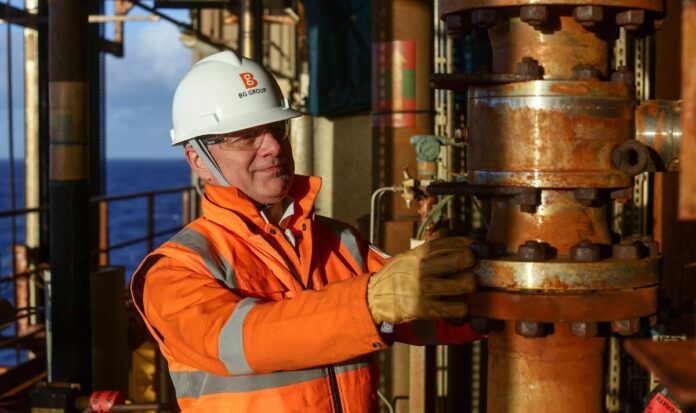The raft of net zero initiatives enshrined into law by Conservative governments past are butting up against the need to guarantee the UK’s energy security and reduce bills for consumers. Back in 2021, Boris Johnson pledged all sectors of the UK economy would be carbon neutral by 2050 – all the carbon dioxide (CO2) emitted being compensated for by carbon capture projects. Scientists believe so-called ‘greenhouse’ gas emissions – among which CO2 is thought to be the worst offender – are responsible for global warming , with devastating consequences for future generations. On Monday, Rishi Sunak confirmed an additional 100 new North Sea production licences would be granted this autumn, insisting the move remained ‘entirely consistent’ with the UK’s climate change commitments. But just how reliant is the UK on fossil fuel extraction these days? And is expanding its scope really as environmentally sound as the Prime Minister claims? The PM made a visit to a freshly-funded carbon capture project in Aberdeenshire on Monday (Image: GETTY) How much oil and gas has the UK extracted from the North Sea historically? Oil was first piped onshore from beneath the bed of the North Sea back in 1971, just over 50 years ago, but widespread exploitation of the reserves discovered didn’t boom until the Eighties. Proven oil reserves peaked at 1.4 billion tonnes in 1977, while proven gas reserves hit a record 815 billion cubic metres two years earlier in 1975. The revenues generated by the industry varied widely depending on global market prices. When these were high between the late Seventies and early Eighties, Government tax receipts reached £12billion. These then slumped until the early Nineties before soaring twelvefold to a record-high £12.4billion by 2008. What does North Sea drilling look like today? The latest available figures show a total of 12,535 offshore wellbores – holes dug into the seabed for exploration or extraction – have been drilled in the North Sea. As of August 2023, 182 rigs are currently in operation across 40 fields. A live map of daily production data per drill is available on the North Sea Transition Authority (NSTA) website. For the 2021 to 2022 financial year, the Treasury earned just over £3.2billion from taxes imposed on oil and gas companies. Which companies are involved? A total of 250 companies – many of which are subsidiaries of larger oil and gas conglomerates – currently benefit from offshore drilling licences in UK waters, according to the NSTA. The list includes household names such as BP, Shell and TotalEnergies, alongside more elusive entries like Union Jack Oil, whose HQ is registered in Bath, and Corfe Energy Limited, whose office address is in Leigh-on-Sea in Essex. Other notables include the Moscow-linked Gazprom International UK and Gazprom UK Resources. Is the UK on track to meet its Net Zero targets? The UK is under a legally binding obligation to be carbon neutral by 2050. In practice, this translates to a 100 percent reduction of CO2 emissions on 1990 levels. Government data show that as of the end of 2022, the country’s total emissions had fallen by 48.7 percent relative to that baseline. Since the mid-2010s, transport has been the most polluting sector, accounting for 24 percent of total greenhouse gas emissions in 2020. A host of initiatives – such as London’s controversial ULEZ scheme – have been put in place in recent years to bear down on this figure. Electricity production had long been on top, but the shift towards renewables and abandonment of coal has made the sector cleaner than ever. The Government faces an even more pressing deadline of 2035 to decarbonise the UK’s power supply. Is expanding North Sea production going to ruin this? Reacting to the announcement of new drilling licences this week, campaigners claimed leaning further into fossil fuels from the North Sea was like sending a ‘wrecking ball through the UK’s climate commitments’. The Government has been pushing back against this. On the one hand, it has been highlighted that new permits don’t automatically mean extraction will ensue – as evidenced by the number of companies holding licences vastly outstripping the number of operational rigs. On the other, the Prime Minister highlighted the Independent Climate Change Committee’s prediction that even when the UK reaches net zero in 2050, roughly a quarter of the country’s energy demand will be met by oil and gas. Over the past year, fossil fuels were behind 39.7 percent of the UK’s electricity production, relative to 35.6 percent for renewables, according to the National Grid. Mr Sunak insisted expanding domestic drilling was ‘the right thing to do’ because imported supplies came with ‘two to three times the carbon footprint of what we have got at home’. Offshore Energies UK – the industry’s trade association – claims there is an environmental ‘bonus’ in extracting hydrocarbons from newer fields because these are designed to minimise leakages and avoid routine flaring, the burning of the natural gases that come with oil extraction that cause the characteristic flame spouts.
UK oil and gas drilling in the North Sea explained in charts and graphs
Sourceexpress.co.uk
RELATED ARTICLES


